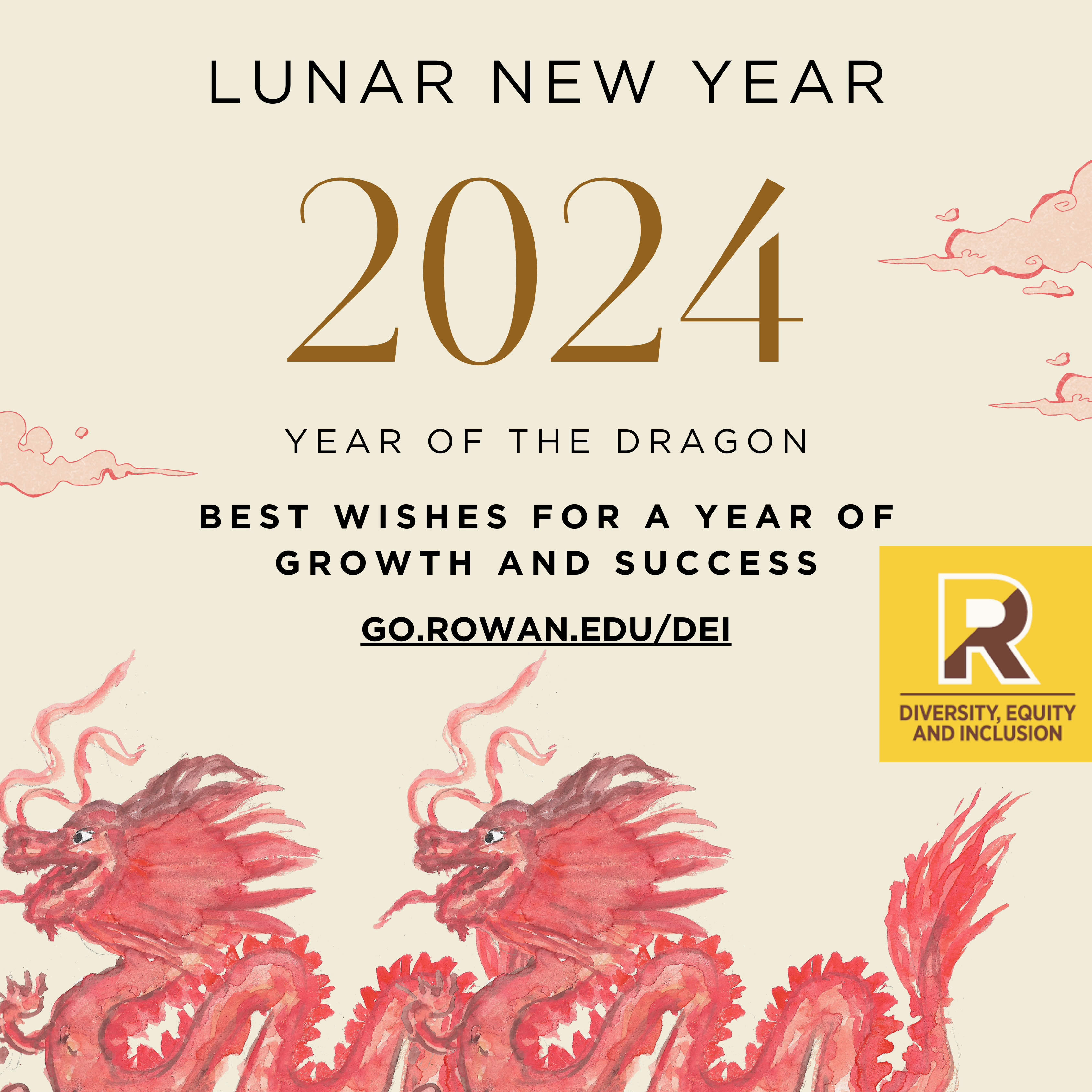
Image Alternative Text: Depicted are two dragons in shades of red, representative of Lunar New Year 2024 and the Year of the Dragon. Clouds in softer shades of red are depicted above the dragons. The text at the center of the graphic reads, "2024;" "Year of the Dragon;" and "Best Wishes for a Year of Growth and Success;" along with the website link to "go.rowan.edu/dei." The Rowan University Division of Diversity, Equity, and Inclusion (DEI) logo is positioned towards the center right corner of the graphic.
Click here to download the graphic.
This article was written by Patricia Fortunato (fortun83@rowan.edu) for the Rowan University Division of Diversity, Equity, and Inclusion (DEI).
Follow the Rowan University Division of DEI:
- Instagram: instagram.com/rowandei
- Facebook: facebook.com/rowandei
- X/Twitter: twitter.com/rowandei
- Threads: threads.net/@rowandei
Chinese Agrarian Tradition and the Arrival of Spring
Lunar New Year is recognized by Asian communities all over the world, as well as Native Hawaiian/Pacific Islander communities. The observance celebrates the arrival of spring per the lunisolar calendar.1 It is the most popular holiday in China, and further celebrated throughout Asia and abroad. The observance is rooted in the Chinese agrarian (agricultural) tradition.2 It is a 15-day celebration that begins during the second moon post-winter solstice. This new year, the celebration began on February 10, commemorating the Year of the Dragon.
The 12 animals in the Chinese zodiac each represent the personality of those born in the respective correlated years.3 The dragon is the sole Chinese zodiac animal that is mythical, and represents fortune and strength. It is also important to note that regions throughout Asia may follow a different zodiac, and many Asian American and Native Hawaiian/Pacific Islander (AANHPI) communities do not observe the Chinese zodiac.
In China and around the world, families celebrate the holiday by decorating their home windows with decorations made of red paper, and their doors with "couplets"—poetry lines written on red paper, affixed on both sides of front doors, and a four-character scroll in horizontal format above the door frame. Couplets are representative of wishes for a successful new year.4 Other traditions include shopping to celebrate the new year; deep cleaning one's home; and the Lunar New Year Eve reunion dinner, wherein family members congregate and enjoy foods that historically hold symbolic meanings, such as oysters, dumplings, "longevity noodles," and yusheng ("abundant life") salad. After dinner, children carry lanterns to symbolize the end of the celebration.
Fostering Inclusion and Celebrating Diversity in New Jersey
In the United States, celebrations in California and New York tend to be the most prominent, representative of the Chinese immigrant populations in each respective state.5 On January 12, 2024, Governor Phil Murphy signed the joint resolution AJR201/SJR111,6 thereby declaring the official annual recognition of Lunar New Year in New Jersey. As Governor Murphy noted, the third-largest per capita population of AANHPI people in the United States resides in New Jersey.7 This statewide recognition strives to foster inclusion, amplify AANHPI culture, and celebrate its diverse people.
In one of my cultures, our Lunar New Year in South Korea is known as Seollal, and during this time, many families travel to South Korean hometowns, honor ancestral spirits, and create an offering of a table of food. Traditional Korean foods, including kimchi mandu (kimchi dumplings) and tteokguk (rice cake soup), are prepared and eaten as part of Seollal. In Indonesia, many families attend local religious centers, with houses of worship typically decorated with red lanterns. Other cultural events include creative artistic performances in Semarang, capital of the province in Central Java, as well as festivals that unify Chinese and Javanese cultures.
An overview of terms concerning Asian communities and language guidance for continued learning, an extensive overview of the Rowan University community of support (an abridged list is also provided below), allyship guidance, and educational resources for continued learning was previously published on the DEI website in March of 2021. Learn more here.
Rowan University Community of Support for Students
- Asian Pacific American Medical Student Association (APAMSA) at Rowan–Virtua School of Osteopathic Medicine (Rowan–Virtua SOM)
- APAMSA at Cooper Medical School of Rowan University (CMSRU)
- Black, Indigenous, and People of Color (BIPOC) Graduate and Professional Student Association (BGPSA)
References
- Yin, S. (2019). What Lunar New Year Reveals About the World's Calendars. The New York Times.
- Wittfogel, K. A. (1957). Chinese Society: Historical Survey. The Journal of Asian Studies, 16(3), 343–364.
- Nakayama, S. (1966). Characteristics of Chinese Astrology. Isis, 57(4), 442–454.
- Hsieh, J., & Chou, Y. H. (1981). Public Aspirations in the New Year Couplets: A Comparative Study Between the People's Republic and Taiwan. Asian Folklore Studies, 125–149.
- Rosenbloom, R., & Batalova, J. (2023). Chinese Immigrants in the United States. Migration Information Source. Migration Policy Institute.
- Office of New Jersey Governor. (2024). Governor Murphy Signs Joint Resolution Designating Lunar New Year in New Jersey. State of New Jersey.
- United States Census Bureau. (2023). QuickFacts New Jersey. United States Department of Commerce.